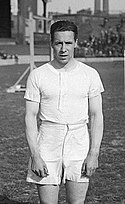Henry Macintosh
 | ||||||||||
| Data i miejsce urodzenia | 10 czerwca 1892 | |||||||||
|---|---|---|---|---|---|---|---|---|---|---|
| Data i miejsce śmierci | 26 lipca 1918 | |||||||||
| Wzrost | 173 cm | |||||||||
| Dorobek medalowy | ||||||||||
| ||||||||||
Hanry Maitland Macintosh (ur. 10 czerwca 1892 w Kelso w Szkocji, zm. 26 lipca 1918 w Albert we Francji[1]) – brytyjski lekkoatleta sprinter, mistrz olimpijski ze Sztokholmu z 1912.
Ukończył Glenalmond College oraz Corpus Christi College w Cambridge.
Na igrzyskach olimpijskich w 1912 w Sztokholmie startował w biegu na 100 metrów (odpadł w przedbiegach) i biegu na 200 metrów (odpadł w półfinale). Sukces odniósł za to w sztafecie 4 × 100 metrów, w której wraz z kolegami (byli to David Jacobs, Victor d’Arcy i William Applegarth) najpierw awansował do finału po dyskwalifikacji sztafety [Stanów Zjednoczonych za przekazanie pałeczki poza strefą zmian, a później w finale zdobył złoty medal. Macintosh biegł na 2. zmianie[1].
W 1913 został prezesem klubu lekkoatletycznego University of Cambridge. Zwyciężył w biegu na 100 jardów podczas meczu z drużyną z University of Oxford. Później, w tym samym roku, zdobył mistrzostwo Szkocji na tym dystansie oraz wyrównał rekord Wielkiej Brytanii (9,8 s). W 1914 ponownie zwyciężył na 100 jardów podczas zawodów Cambridge – Oksford.
Wszystkie rekordy życiowe ustanowił w roku 1913[1]:
- 100 y – 9,8 s.
- 100 m – 10,7 s.
- 200 m – 22,1 s.
Po wybuchu I wojny światowej służył w regimencie Argyll and Sutherland Highlanders. Zmarł w stopniu kapitana z ran odniesionych w drugiej bitwie nad Sommą podczas ofensywy stu dni[1]. Został pochowany na cmentarzu w Senlis.
Przypisy
- ↑ a b c d Henry Macintosh, olympedia.org [dostęp 2020-08-16] (ang.).
Media użyte na tej stronie
Pictograms of Olympic sports – . This is an unofficial sample picture. Images of official Olympic pictograms for 1948 Summer Olympics and all Summer Olympics since 1964 can be found in corresponding Official Reports.
The flag of Navassa Island is simply the United States flag. It does not have a "local" flag or "unofficial" flag; it is an uninhabited island. The version with a profile view was based on Flags of the World and as a fictional design has no status warranting a place on any Wiki. It was made up by a random person with no connection to the island, it has never flown on the island, and it has never received any sort of recognition or validation by any authority. The person quoted on that page has no authority to bestow a flag, "unofficial" or otherwise, on the island.
Flag of the unified Team of Germany for the Olympic Games, 1960–1968.
Flag of Canada introduced in 1965, using Pantone colors. This design replaced the Canadian Red Ensign design.
Flag of Jamaica. “The sunshine, the land is green, and the people are strong and bold” is the symbolism of the colours of the flag. GOLD represents the natural wealth and beauty of sunlight; GREEN represents hope and agricultural resources; BLACK represents the strength and creativity of the people. The original symbolism, however, was "Hardships there are, but the land is green, and the sun shineth", where BLACK represented the hardships being faced.
Competitors in the Civil Service Athletic Sports 220 yards race at Stamford Bridge in London. Henry Macintosh








